Profiling of the Polyphenol Content of Honey from Different Geographical Origins in the United States
Abstract
1. Introduction
2. Results and Discussion
2.1. Physicochemical Properties of Honey
2.1.1. TPC of Honey Compared to Other Geographical Sources
2.1.2. TPC vs. Honey Physicochemical Properties
2.1.3. pH of Honey
2.1.4. Color of Honey
2.1.5. Moisture Content of Honey
2.1.6. HMF Determination in Honey
2.2. Identification of Phenolic Compounds in Honey
2.3. Chemometric Tools for Honey Classification Analysis
3. Materials and Methods
3.1. Chemicals and Reagents
3.2. Collection of Honey Samples
3.3. Standards Preparation
3.4. Extraction of Phenolic Compounds in Honey
3.5. Determination of Total Polyphenol Content (TPC) in Honey
3.6. Physicochemical Properties of Honey
3.6.1. 5-Hydroxymethylfurfural (HMF) Determination in Honey
3.6.2. Moisture Content in Honey
3.6.3. pH Determination
3.6.4. Color of Honey
3.6.5. Profiling of Polyphenols in Honey by HPLC-MS
3.7. Statistical Analysis
4. Conclusions
Supplementary Materials
Author Contributions
Funding
Institutional Review Board Statement
Informed Consent Statement
Data Availability Statement
Conflicts of Interest
Sample Availability
References
- Jibril, F.I.; Hilmi, A.B.M.; Manivannan, L. Isolation and characterization of polyphenols in natural honey for the treatment of human diseases. Bull. Natl. Res. Cent. 2019, 43, 4. [Google Scholar] [CrossRef]
- Bravo, L. Polyphenols: Chemistry, Dietary Sources, Metabolism, and Nutritional Significance. Nutr. Rev. 1998, 56, 317–333. [Google Scholar] [CrossRef] [PubMed]
- Cianciosi, D.; Forbes-Hernández, T.Y.; Afrin, S.; Gasparrini, M.; Reboredo-Rodriguez, P.; Manna, P.P.; Zhang, J.; Lamas, L.B.; Flórez, S.M.; Toyos, P.A.; et al. Phenolic Compounds in Honey and Their Associated Health Benefits: A Review. Molecules 2018, 23, 2322. [Google Scholar] [CrossRef]
- Koulis, G.A.; Tsagkaris, A.S.; Aalizadeh, R.; Dasenaki, M.E.; Panagopoulou, E.I.; Drivelos, S.; Halagarda, M.; Georgiou, C.A.; Proestos, C.; Thomaidis, N.S. Honey Phenolic Compound Profiling and Authenticity Assessment Using HRMS Targeted and Untargeted Metabolomics. Molecules 2021, 26, 2769. [Google Scholar] [CrossRef]
- Wang, X.; Chen, Y.; Hu, Y.; Zhou, J.; Chen, L.; Lu, X. Systematic Review of the Characteristic Markers in Honey of Various Botanical, Geographic, and Entomological Origins. ACS Food Sci. Technol. 2022, 2, 206–220. [Google Scholar] [CrossRef]
- Truchado, P.; Ferreres, F.; Tomas-Barberan, F.A. Liquid chromatography–tandem mass spectrometry reveals the widespread occurrence of flavonoid glycosides in honey, and their potential as floral origin markers. J. Chromatogr. A 2009, 1216, 7241–7248. [Google Scholar] [CrossRef] [PubMed]
- Yao, L.; Datta, N.; Tomás-Barberán, F.A.; Ferreres, F.; Martos, I.; Singanusong, R. Flavonoids, phenolic acids and abscisic acid in Australian and New Zealand Leptospermum honeys. Food Chem. 2003, 81, 159–168. [Google Scholar] [CrossRef]
- Biesaga, M.; Pyrzyńska, K. Stability of bioactive polyphenols from honey during different extraction methods. Food Chem. 2012, 136, 46–54. [Google Scholar] [CrossRef] [PubMed]
- Da Silva, P.M.; Gauche, C.; Gonzaga, L.V.; Costa, A.C.O.; Fett, R. Honey: Chemical composition, stability and authenticity. Food Chem. 2016, 196, 309–323. [Google Scholar] [CrossRef]
- Escriche, I.; Kadar, M.; Juan-Borrás, M.; Domenech, E. Suitability of antioxidant capacity, flavonoids and phenolic acids for floral authentication of honey. Impact of industrial thermal treatment. Food Chem. 2014, 142, 135–143. [Google Scholar] [CrossRef]
- Jasicka-Misiak, I.; Makowicz, E.; Stanek, N. Chromatographic fingerprint, antioxidant activity, and colour characteristic of polish goldenrod (Solidago virgaurea L.) honey and flower. Eur. Food Res. Technol. 2018, 244, 1169–1184. [Google Scholar] [CrossRef]
- Kujawski, M.W.; Namieśnik, J. Challenges in preparing honey samples for chromatographic determination of contaminants and trace residues. TrAC Trends Anal. Chem. 2008, 27, 785–793. [Google Scholar] [CrossRef]
- Lamas, M.; Rodrigues, F.; Amaral, M.H.; Delerue-Matos, C.; Fernandes, V.C. Contaminant Cocktails of High Concern in Honey: Challenges, QuEChERS Extraction and Levels. Separations 2023, 10, 142. [Google Scholar] [CrossRef]
- Michalkiewicz, A.; Biesaga, M.; Pyrzynska, K. Solid-phase extraction procedure for determination of phenolic acids and some flavonols in honey. J. Chromatogr. A 2008, 1187, 18–24. [Google Scholar] [CrossRef]
- Sergiel, I.; Pohl, P.; Biesaga, M. Characterisation of honeys according to their content of phenolic compounds using high performance liquid chromatography/tandem mass spectrometry. Food Chem. 2014, 145, 404–408. [Google Scholar] [CrossRef]
- Kaškonien, V.; Maruška, A.; Kornyšova, O. Quantitative and Qualitative Determination of Phenolic Compounds in Honey. Chemine Technol. Nr. 2009, 3, 74–80. [Google Scholar]
- Vazquez, L.; Armada, D.; Celeiro, M.; Dagnac, T.; Llompart, M. Evaluating the Presence and Contents of Phytochemicals in Honey Samples: Phenolic Compounds as Indicators to Identify Their Botanical Origin. Foods 2021, 10, 2616. [Google Scholar] [CrossRef]
- Trautvetter, S.; Koelling-speer, I.; Speer, K.; Trautvetter, S.; Koelling-speer, I.; Speer, K. Confirmation of Phenolic Acids and Flavonoids in Honeys by UPLC-MS To Cite This Version: HAL Id: Hal-00892006 Original Article by UPLC-MS. Apidologie 2009, 40, 140–150. [Google Scholar] [CrossRef]
- Ciucure, C.T.; Geană, E.-I. Phenolic compounds profile and biochemical properties of honeys in relationship to the honey floral sources. Phytochem. Anal. 2019, 30, 481–492. [Google Scholar] [CrossRef]
- Becerril-Sánchez, A.L.; Quintero-Salazar, B.; Dublán-García, O.; Escalona-Buendía, H.B. Phenolic Compounds in Honey and Their Relationship with Antioxidant Activity, Botanical Origin, and Color. Antioxidants 2021, 10, 1700. [Google Scholar] [CrossRef] [PubMed]
- Bertoncelj, J.; Doberšek, U.; Jamnik, M.; Golob, T. Evaluation of the phenolic content, antioxidant activity and colour of Slovenian honey. Food Chem. 2007, 105, 822–828. [Google Scholar] [CrossRef]
- Aljadi, A.M.; Kamaruddin, M.Y. Evaluation of the phenolic contents and antioxidant capacities of two Malaysian floral honeys. Food Chem. 2004, 85, 513–518. [Google Scholar] [CrossRef]
- Boussaid, A.; Chouaibi, M.; Rezig, L.; Hellal, R.; Donsì, F.; Ferrari, G.; Hamdi, S. Physicochemical and bioactive properties of six honey samples from various floral origins from Tunisia. Arab. J. Chem. 2018, 11, 265–274. [Google Scholar] [CrossRef]
- Al-Farsi, M.; Al-Amri, A.; Al-Hadhrami, A.; Al-Belushi, S. Color, flavonoids, phenolics and antioxidants of Omani honey. Heliyon 2018, 4, e00874. [Google Scholar] [CrossRef] [PubMed]
- Cabrera, M.; Perez, M.; Gallez, L.; Andrada, A.; Balbarrey, G. Colour, antioxidant capacity, phenolic and flavonoid content of honey from the Humid Chaco Region, Argentina. Phyton Int. J. Exp. Bot. 2017, 86, 124–130. [Google Scholar] [CrossRef]
- Tsagkaris, A.S.; Koulis, G.A.; Danezis, G.P.; Martakos, I.; Dasenaki, M.; Georgiou, C.A.; Thomaidis, N.S. Honey authenticity: Analytical techniques, state of the art and challenges. RSC Adv. 2021, 11, 11273–11294. [Google Scholar] [CrossRef]
- Alvarez-Suarez, J.M.; Giampieri, F.; Brenciani, A.; Mazzoni, L.; Gasparrini, M.; González-Paramás, A.M.; Santos-Buelga, C.; Morroni, G.; Simoni, S.; Forbes-Hernández, T.Y.; et al. Apis mellifera vs Melipona beecheii Cuban polifloral honeys: A comparison based on their physicochemical parameters, chemical composition and biological properties. LWT 2018, 87, 272–279. [Google Scholar] [CrossRef]
- Jasicka-Misiak, I.; Gruyaert, S.; Poliwoda, A.; Kafarski, P. Chemical Profiling of Polyfloral Belgian Honey: Ellagic Acid and Pinocembrin as Antioxidants and Chemical Markers. J. Chem. 2017, 2017, 5393158. [Google Scholar] [CrossRef]
- Habryka, C.; Socha, R.; Juszczak, L. Effect of Bee Pollen Addition on the Polyphenol Content, Antioxidant Activity, and Quality Parameters of Honey. Antioxidants 2021, 10, 810. [Google Scholar] [CrossRef]
- Martín, R.A.P.; Hortigüela, L.V.; Lozano, P.L.; Cortina, M.D.R.; Carretero, C.d.L. In Vitro Antioxidant and Antimicrobial Activities of Spanish Honeys. Int. J. Food Prop. 2008, 11, 727–737. [Google Scholar] [CrossRef]
- Do Nascimento, K.S.; Sattler, J.A.G.; Macedo, L.F.L.; González, C.V.S.; de Melo, I.L.P.; da Silva Araújo, E.; Granato, D.; Sattler, A.; de Almeida-Muradian, L.B. Phenolic compounds, antioxidant capacity and physicochemical properties of Brazilian Apis mellifera honeys. LWT 2018, 91, 85–94. [Google Scholar] [CrossRef]
- Bertoncelj, J.; Polak, T.; Kropf, U.; Korošec, M.; Golob, T. LC-DAD-ESI/MS analysis of flavonoids and abscisic acid with chemometric approach for the classification of Slovenian honey. Food Chem. 2011, 127, 296–302. [Google Scholar] [CrossRef]
- Zhao, J.; Du, X.; Cheng, N.; Chen, L.; Xue, X.; Wu, L.; Cao, W. Identification of monofloral honeys using HPLC–ECD and chemometrics. Food Chem. 2016, 194, 167–174. [Google Scholar] [CrossRef]
- Conti, M.E. Lazio region (central Italy) honeys: A survey of mineral content and typical quality parameters. Food Control. 2000, 11, 459–463. [Google Scholar] [CrossRef]
- Terrab, A.; Recamales, A.F.; Hernanz, D.; Heredia, F.J. Characterisation of Spanish thyme honeys by their physicochemical characteristics and mineral contents. Food Chem. 2004, 88, 537–542. [Google Scholar] [CrossRef]
- Rebiai, A.; Lanez, T.; Chouikh, A. Physicochemical and Biochemical Properties of Honey Bee Products in South Algeria. Sci. Study Res. Chem. Chem. Eng. Biotechnol. Food Ind. 2015, 16, 133–142. [Google Scholar]
- Alimentarius, C. Revised Codex Standard for Honey; Codex Stan. 12-1981, Revision 1 (1987); World Health Organization: Rome, Italy, 2001; p. 2. [Google Scholar]
- Marcazzan, G.L.; Mucignat-Caretta, C.; Marchese, C.M.; Piana, M.L. A review of methods for honey sensory analysis. J. Apic. Res. 2017, 57, 75–87. [Google Scholar] [CrossRef]
- Persano Oddo, L.; Piro, R. Main European Unifloral Honeys: Descriptive Sheets. Apidologie 2004, 35, 38–81. [Google Scholar] [CrossRef]
- Beretta, G.; Granata, P.; Ferrero, M.; Orioli, M.; Facino, R.M. Standardization of antioxidant properties of honey by a combination of spectrophotometric/fluorimetric assays and chemometrics. Anal. Chim. Acta 2005, 533, 185–191. [Google Scholar] [CrossRef]
- Shafiee, S.; Minaei, S.; Moghaddam-Charkari, N.; Ghasemi-Varnamkhasti, M.; Barzegar, M. Potential application of machine vision to honey characterization. Trends Food Sci. Technol. 2013, 30, 174–177. [Google Scholar] [CrossRef]
- Nagai, T.; Kai, N.; Tanoue, Y.; Suzuki, N. Chemical properties of commercially available honey species and the functional properties of caramelization and Maillard reaction products derived from these honey species. J. Food Sci. Technol. 2018, 55, 586–597. [Google Scholar] [CrossRef]
- Marshall, S.M.; Schneider, K.R.; Cisneros, K.V.; Gu, L. Determination of Antioxidant Capacities, α-Dicarbonyls, and Phenolic Phytochemicals in Florida Varietal Honeys Using HPLC-DAD-ESI-MSn. J. Agric. Food Chem. 2014, 62, 8623–8631. [Google Scholar] [CrossRef] [PubMed]
- Ciappini, M.; Gatti, M.; Di Vito, M. El Color Como Indicador Del Contenido de Flavonoides En Miel. Rev. Cienc. Tecnol. 2013, 15, 59–63. [Google Scholar]
- Balcázar, L.; Valadez, A.; López, J.; Ochoa, A.; Rodríguez, L.; López, E. Relación Del Contenido de Flavonoides y Color En Miel de Abeja (Apis Mellifera) Originaria Del Estado de Tabasco, México. Investig. Desarro. Cienc. Tecnol. Aliment. 2019, 4, 818–825. [Google Scholar]
- Singh, I.; Singh, S. Honey moisture reduction and its quality. J. Food Sci. Technol. 2018, 55, 3861–3871. [Google Scholar] [CrossRef] [PubMed]
- Saxena, S.; Gautam, S.; Sharma, A. Physical, biochemical and antioxidant properties of some Indian honeys. Food Chem. 2010, 118, 391–397. [Google Scholar] [CrossRef]
- Mihaly Cozmuta, A.; Mihaly Cozmuta, L.; Peter, A.; Varga, C.; Marian, M. Effect of Thermal Processing on Quality of Polyfloral Honey Romanian Journal of Food Science Effect of Thermal Processing on Quality of Polyfloral Honey. Rom. J. Food Sci. 2010, 1, 45–52. [Google Scholar]
- Singh, N.; Bath, P.K. Relationship between Heating and Hydroxymethylfurfural Formation in Different Honey Types. J. Food Sci. Technol.-Mysore 1998, 35, 154–156. [Google Scholar]
- Hase, S.; Suzuki, O.; Odate, M.; Suzuki, S. Changes in Quality of Honey Caused by Heating and Storage Part I. Changes in Hydroxymethylfurfural (HMF) Content of Honey. Nippon Shokuhin Kogyo Gakkaishi 1973, 20, 248–256. [Google Scholar] [CrossRef]
- Khalil, M.I.; Sulaiman, S.A.; Gan, S.H. High 5-hydroxymethylfurfural concentrations are found in Malaysian honey samples stored for more than one year. Food Chem. Toxicol. 2010, 48, 2388–2392. [Google Scholar] [CrossRef]
- Daglia, M. Polyphenols as antimicrobial agents. Curr. Opin. Biotechnol. 2012, 23, 174–181. [Google Scholar] [CrossRef] [PubMed]
- Socha, R.; Juszczak, L.; Pietrzyk, S.; Gałkowska, D.; Fortuna, T.; Witczak, T. Phenolic profile and antioxidant properties of Polish honeys. Int. J. Food Sci. Technol. 2011, 46, 528–534. [Google Scholar] [CrossRef]
- Baltrušaitytė, V.; Venskutonis, P.R.; Čeksterytė, V. Radical scavenging activity of different floral origin honey and beebread phenolic extracts. Food Chem. 2007, 101, 502–514. [Google Scholar] [CrossRef]
- Čeksteryte, V.; Kazlauskas, S. Composition of Flavonoids in Lithuanian Honey and Beebread. Biologija 2006, 2, 28–33. [Google Scholar]
- Kenjerić, D.; Mandić, M.L.; Primorac, L.; Bubalo, D.; Perl, A. Flavonoid profile of Robinia honeys produced in Croatia. Food Chem. 2007, 102, 683–690. [Google Scholar] [CrossRef]
- Perna, A.; Intaglietta, I.; Simonetti, A.; Gambacorta, E. A comparative study on phenolic profile, vitamin C content and antioxidant activity of Italian honeys of different botanical origin. Int. J. Food Sci. Technol. 2013, 48, 1899–1908. [Google Scholar] [CrossRef]
- Kečkeš, S.; Gašić, U.; Veličković, T.Ć.; Milojković-Opsenica, D.; Natić, M.; Tešić, Ž. The determination of phenolic profiles of Serbian unifloral honeys using ultra-high-performance liquid chromatography/high resolution accurate mass spectrometry. Food Chem. 2013, 138, 32–40. [Google Scholar] [CrossRef]
- Lachman, J.; Hejtmánková, A.; Sýkora, J.; Karban, J.; Orsák, M.; Rygerová, B. Contents of major phenolic and flavonoid antioxidants in selected Czech honey. Czech J. Food Sci. 2010, 28, 412–426. [Google Scholar] [CrossRef]
- García-Seval, V.; Saurina, J.; Sentellas, S.; Núñez, O. Off-Line SPE LC-LRMS Polyphenolic Fingerprinting and Chemometrics to Classify and Authenticate Spanish Honey. Molecules 2022, 27, 7812. [Google Scholar] [CrossRef] [PubMed]
- Yayinie, M.; Atlabachew, M.; Tesfaye, A.; Hilluf, W.; Reta, C.; Alemneh, T. Polyphenols, flavonoids, and antioxidant content of honey coupled with chemometric method: Geographical origin classification from Amhara region, Ethiopia. Int. J. Food Prop. 2022, 25, 76–92. [Google Scholar] [CrossRef]
- Chong, I.-G.; Jun, C.-H. Performance of some variable selection methods when multicollinearity is present. Chemom. Intell. Lab. Syst. 2005, 78, 103–112. [Google Scholar] [CrossRef]
- Ballabio, D.; Consonni, V. Classification tools in chemistry. Part 1: Linear models. PLS-DA. Anal. Methods 2013, 5, 3790–3798. [Google Scholar] [CrossRef]
- Singleton, V.L.; Rossi, J.A., Jr.; Rossi, J.A., Jr. Colorimetry of Total Phenolics with Phosphomolybdic-Phosphotungstic Acid Reagents. Am. J. Enol. Vitic. 1965, 16, 144–158. [Google Scholar] [CrossRef]
- White, J.W. Spectrophotometric Method for Hydroxymethylfurfural in Honey. J. AOAC Int. 1979, 62, 509–514. [Google Scholar] [CrossRef]
- Bogdanov, S. Harmonised Methods of the International IHC. Bee Prod. Sci. 2009, 5, 1–62. [Google Scholar]
- White, J.W.; Beaty, C.M.R.; Eaton, W.G.; Hart, B.; Huser, W.; Killion, E.; Lamssies, R.R.; Lee, T.; Moen, W.E. Instrumental Color Classification of Honey: Collaborative Study. J. Assoc. Off. Anal. Chem. 2008, 67, 1983–1985. [Google Scholar]
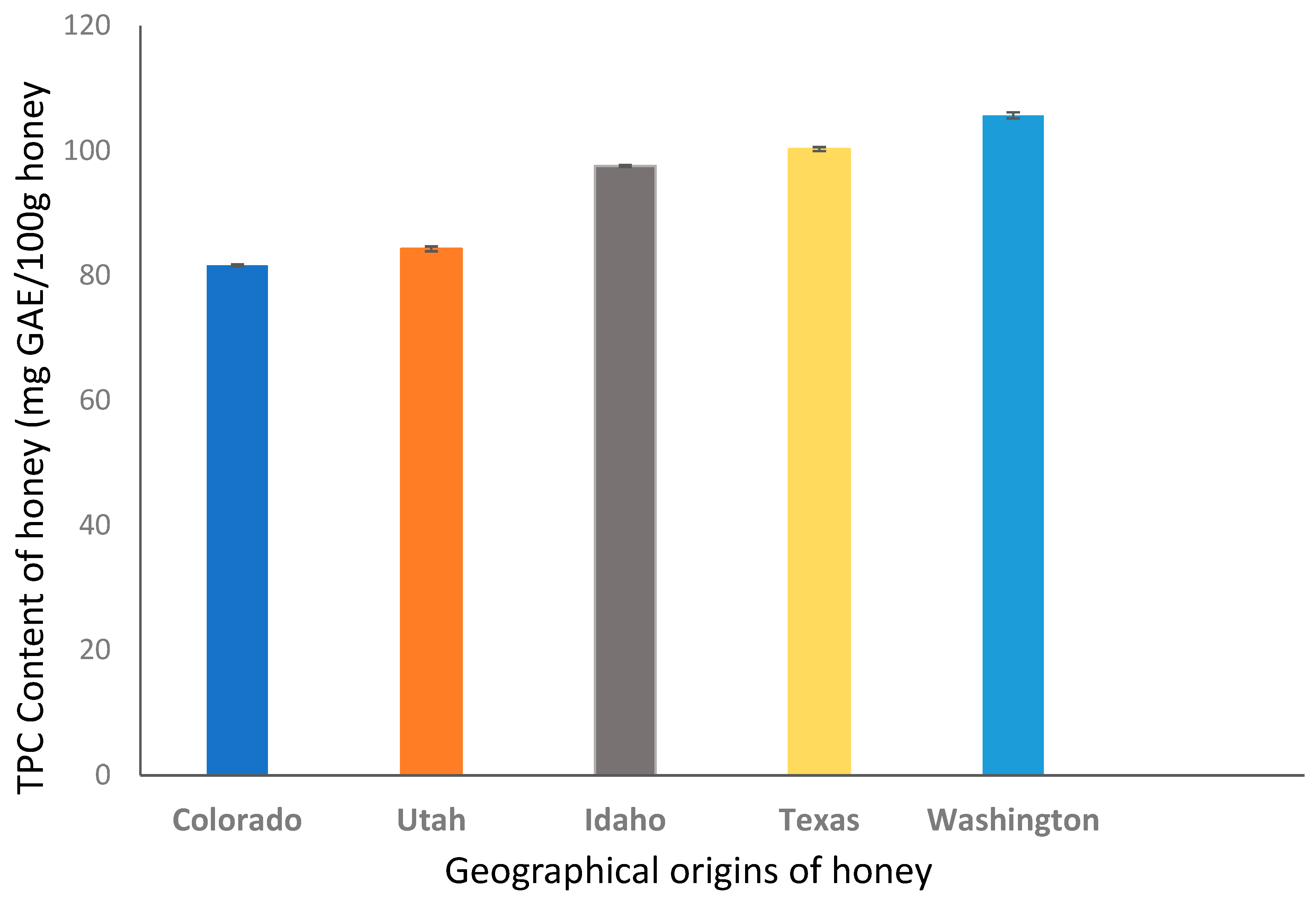
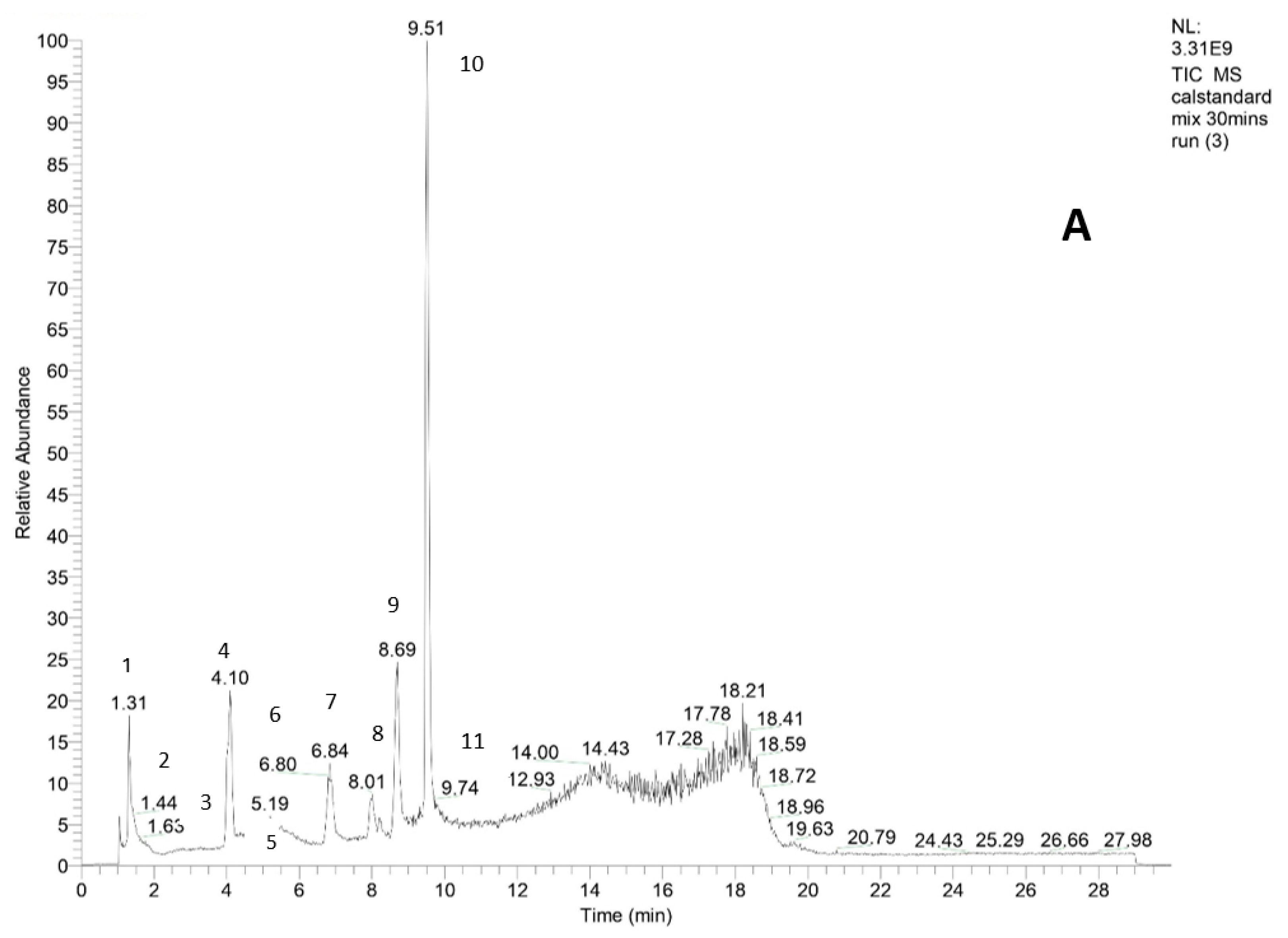
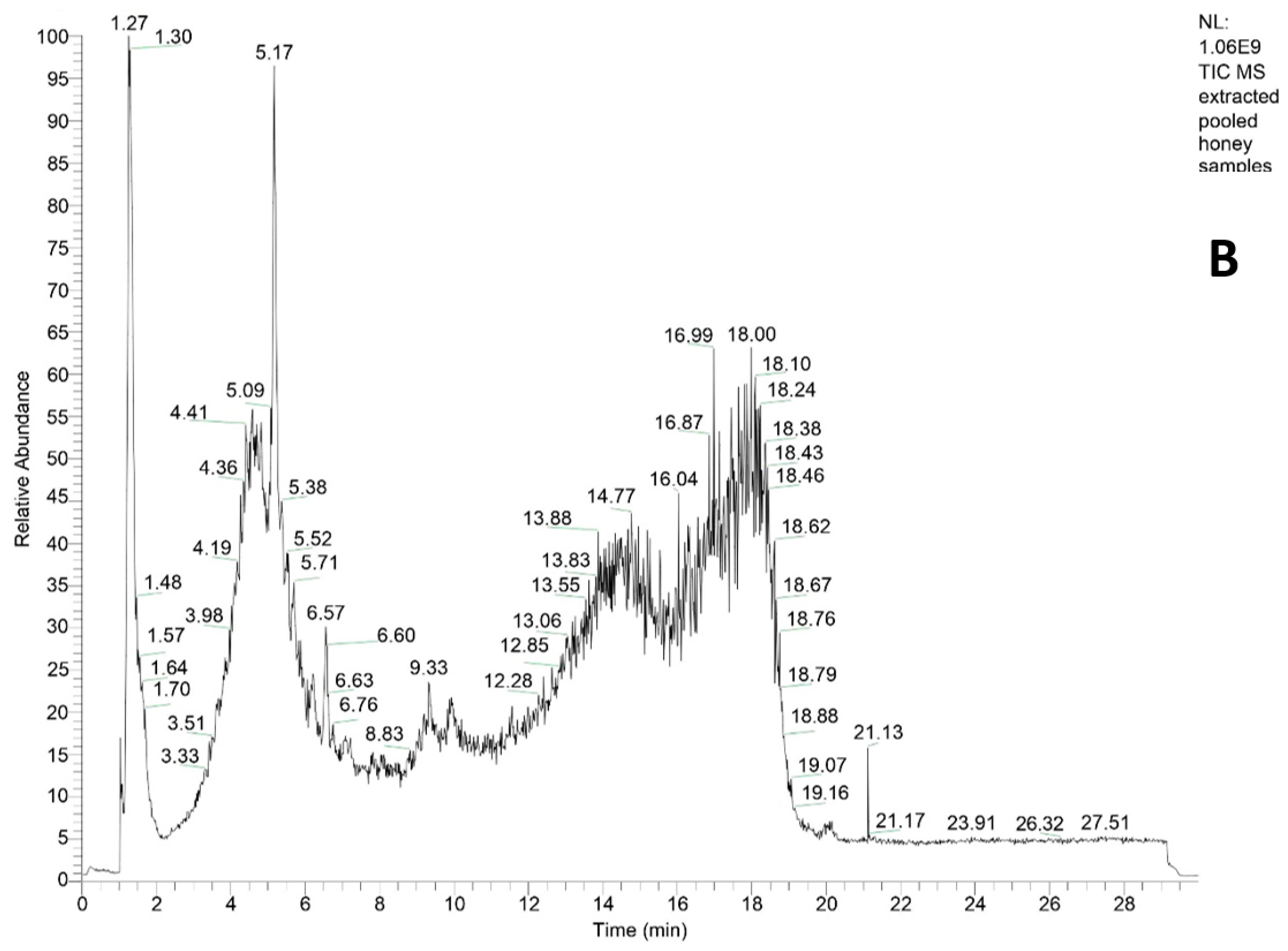

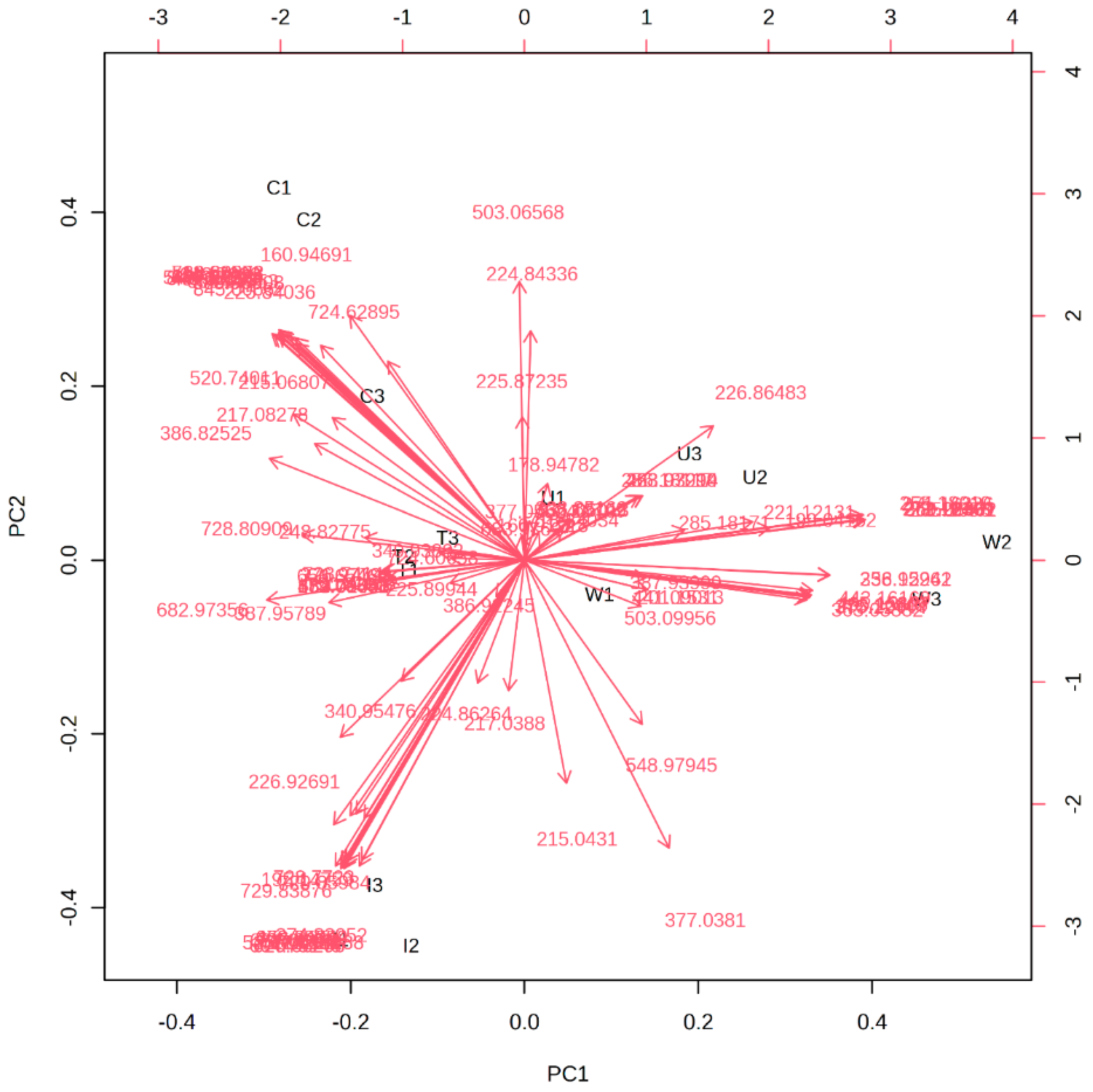
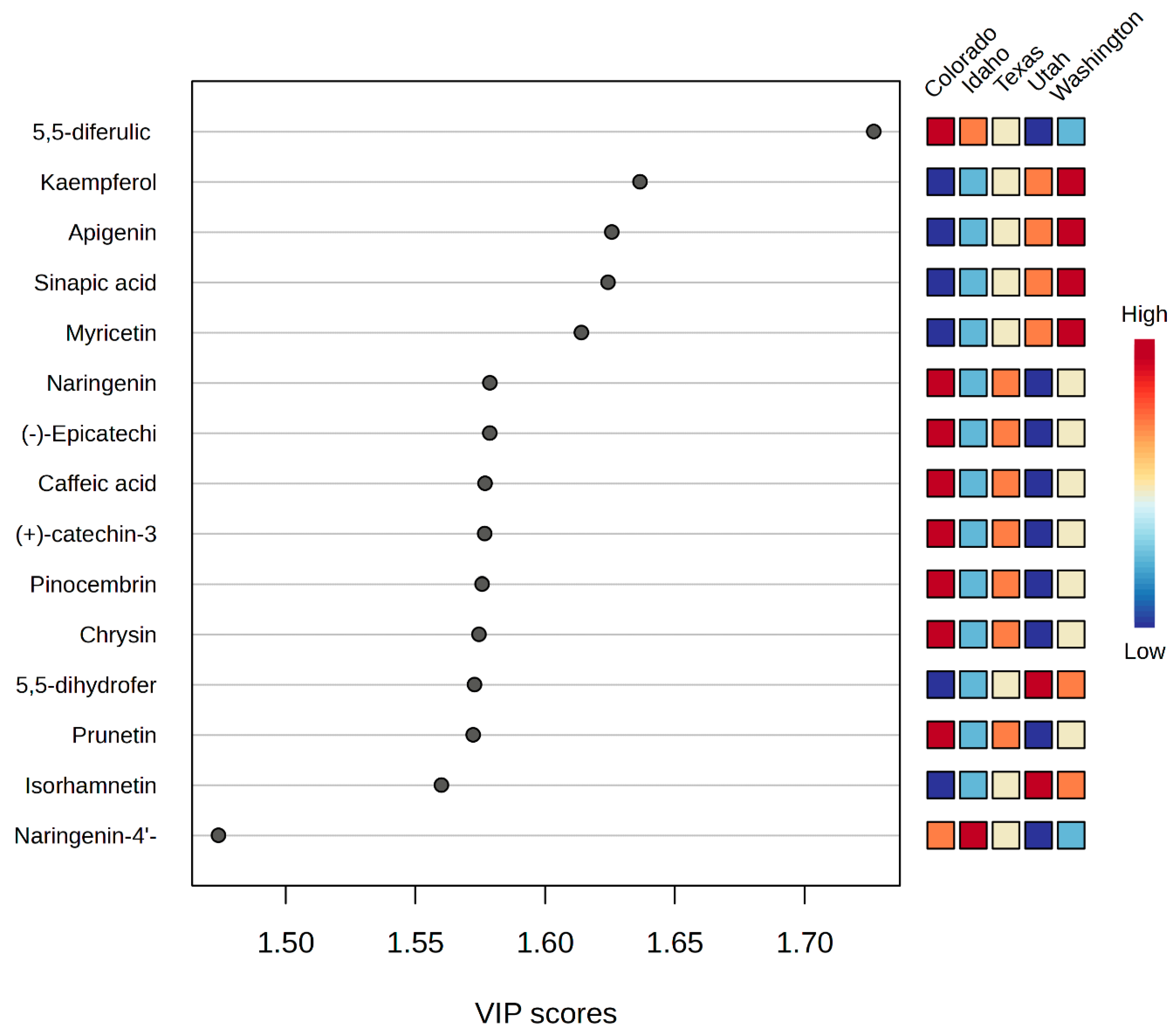
| Sample Origin | Color (mm Pfund Value) | %Water Content (g/100 g) | HMF Levels (mg/kg) | pH | TPC (mg GAE/100 g) |
|---|---|---|---|---|---|
| Colorado | Amber (88.8) | 17.2 | 5.6 | 5.5 | 81.6 |
| Idaho | Amber (102.8) | 16.8 | 8.2 | 5.5 | 97.5 |
| Texas | Dark amber (116.3) | 18.2 | 9.9 | 5.4 | 100.2 |
| Utah | Light amber (64.4) | 16.4 | 5.5 | 5.4 | 84.3 |
| Washington | Dark amber (118.2) | 18.0 | 12.1 | 5.4 | 105.7 |
| Codex Alimentarius Standard Commission (2001) | Nearly white to dark amber | <20% | <40 mg/kg or <80 mg/kg (regions with tropical temperatures) | 3.5–6.0 | |
| Regression coefficient (r) | 0.931 | 0.036 | 0.467 | 0.169 |
| Phenolic Compounds | Mass [M-H]− (Da) | Makers of Geographical Origin | Polyphenol Class |
|---|---|---|---|
| Caffeic acid | 178.95 | Texas | Phenolic acid |
| Kaempferol | 285.15 | Washington | Flavonol |
| Apigenin | 269.22 | Washington | Flavone |
| Pinocembrin | 255.18 | Washington/Colorado | Flavanone |
| Subaphyllin | 263.03 | Utah | Phenolic acid |
| Kaempferol-3-O-rhamnoside | 428.98 | Utah | Flavanol glycoside |
| Ferulic acid-5-5-dihydroferulic acid | 386.94 | Colorado/Texas | Phenolic acid |
| 6-Prenylnaringenin | 338.85 | Utah | Flavanone |
| (+)-Catechin 3-O-glucose | 452.03 | Colorado/Texas | Flavanol glycoside |
| Myricetin | 316.82 | Idaho | Flavanol |
| Quercetin 3-O-(6″-malonyl-glucoside) | 548.96 | Colorado | Flavonol |
| (-)-Epicatechin 4’-O-glucuronide | 465.18 | Utah | Flavonol |
Disclaimer/Publisher’s Note: The statements, opinions and data contained in all publications are solely those of the individual author(s) and contributor(s) and not of MDPI and/or the editor(s). MDPI and/or the editor(s) disclaim responsibility for any injury to people or property resulting from any ideas, methods, instructions or products referred to in the content. |
© 2023 by the authors. Licensee MDPI, Basel, Switzerland. This article is an open access article distributed under the terms and conditions of the Creative Commons Attribution (CC BY) license (https://creativecommons.org/licenses/by/4.0/).
Share and Cite
Nyarko, K.; Boozer, K.; Greenlief, C.M. Profiling of the Polyphenol Content of Honey from Different Geographical Origins in the United States. Molecules 2023, 28, 5011. https://doi.org/10.3390/molecules28135011
Nyarko K, Boozer K, Greenlief CM. Profiling of the Polyphenol Content of Honey from Different Geographical Origins in the United States. Molecules. 2023; 28(13):5011. https://doi.org/10.3390/molecules28135011
Chicago/Turabian StyleNyarko, Kate, Kaitlyn Boozer, and C. Michael Greenlief. 2023. "Profiling of the Polyphenol Content of Honey from Different Geographical Origins in the United States" Molecules 28, no. 13: 5011. https://doi.org/10.3390/molecules28135011
APA StyleNyarko, K., Boozer, K., & Greenlief, C. M. (2023). Profiling of the Polyphenol Content of Honey from Different Geographical Origins in the United States. Molecules, 28(13), 5011. https://doi.org/10.3390/molecules28135011








